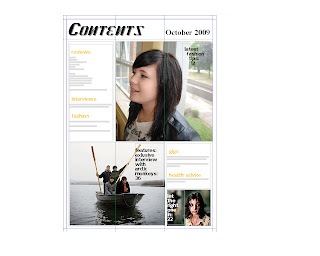 Magazine: Q
Magazine: QGenre: Indie, pop, rock and classic rock.
Audience: 21 – 35, succeeders, carers, traditionalists (psychographics) as well as post-materialists (social values). JICNAR SCALE: B – Intermediate managerial, administrative and professional (GPs, teachers) / C1 – Supervisory, clerical, junior administrative or professional (work in offices).
Title: Simple, no stupid titles or puns – just straight to the point. Also a well know and trusted name.
Style: A red, black and white colour scheme (simple) with the known Q logo at the top left hand corner. Layout quite plain – established magazine doesn’t need to really capture the audience’s attention because it already has a group dedicated readers.
Content: You’d expect to find features and articles about classic artists (Paul McCartney, Robert Plant) as well as other major/mainstream more recent artists (Kings of Leon, Lily Allen). Quite often issues featuring things like ‘Top 50 greatest albums of all time’ or ‘100 greatest songs of the decade’ etc…
Mode of address: Q uses a simple and straightforward language in order to appeal to its demographic and also a wider audience; anybody could pick it up and understand what they’re blabbing on about. They also quote interviews with artists (normally something a bit extreme or unusual) in order to attract the reader, for example; “I save all my beard clippings in a bag to send to Neil Tennant” – Brandon Flowers. These quotes often sum up that person and their style of music e.g. When you think of Billie Joe Armstrong, you think of his band and lyrics which are strongly against the old republican government, so they use this quote: “If I went for a beer with Bush, hopefully I’d have a gun on me.” Very funny, even if it does contradict everything he supposedly believes in, but what else could you expect from a sell out?
Photographs: The photographs within Q magazine are pictures of well known and established (sometimes up and coming) British and American musicians, these artists often integrate and have special features where a new artist will interview a “legend” and vice versa. A lot of these pictures are taken in a studio with a simple backdrop (white or black), the musicians don’t tend to smile and look very serious because that’s what Q would like people to think it is; a serious music magazine. This represents the artists in quite a serious, noble and pretentious light; to some they would seem impressive and mighty, but to others they just look ridiculously snobbish and up themselves.
Contents page: The contents page includes or the main artists within its big feature (“Artist of the Century”) it also shows regular features and a special review. At the top right hand corner it displays the front cover and at the bottom right hand corner it reveals a page deep within the actual magazine. Q uses a 3 column contents page.
Double page spreads: One the first page, it includes a big statement in a sans serif font, then three columns of the beginnings of an article. On the second page there is a collage of images representing the Noughties; music, media, politics and so on. It combines simplicity and words with a clash of colour and photographs.
An example of the kind of band you'd find in Q:

 Classic FM
Classic FM





